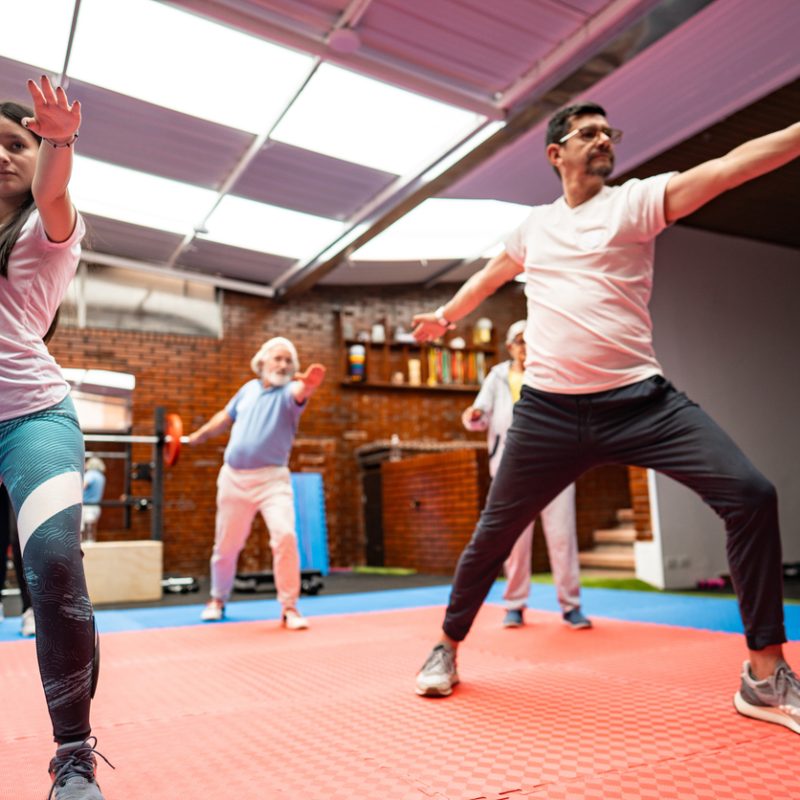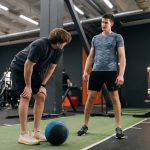
Low-impact exercises are physical activities that minimize stress on the joints while still providing cardiovascular, strength, and flexibility benefits (Tse et al., 2015).
What is Low-Impact Exercise?
Low-impact exercise is any physical activity that puts minimal stress on your joints. It’s gentler on the body compared to high-impact exercises (like running or jumping), making it ideal for:
- Beginners
- Injury Recovery
- Adults Advanced in Age
- Anyone who wants a sustainable fitness routine
What Makes it Low-Impact?
At least one foot stays on the ground at all times (in most cases).
No jarring or pounding motions on your joints.
Movements are usually controlled and smooth.
What Low-Impact Isn’t
Low impact does NOT mean low intensity. You can still work up a sweat, build strength, and improve fitness.
Common Low-Impact Exercises
Chances are that you’re already incorporating these exercises in your programming. If you aren’t, you can always start, especially with clients who need to get their heart rate up and aren’t able to do movements like plyometric hops or wind sprints. You can also use these for active recovery days for your clients who are used to doing exercises like High-Intensity Interval Training (HIIT).
- Walking
Simple, effective, and easy to do almost anywhere. - Cycling
Great cardio with little to no joint pressure. - Swimming
Full-body workout, joint-friendly thanks to water support. - Elliptical Machine
Smooth motion mimics running without impact. - Yoga
Improves flexibility, balance, and mindfulness. - Pilates
Builds core strength, posture, and mobility. - Tai Chi
Enhances balance and consists of flowing movements. - Water Aerobics
Excellent resistance training with little impact. - Low-Impact Dance
Gentle Dance adds an element of fun and variation. - Strength Training
Builds muscle and improves bone strength.
Low-impact options include using dumbbells, resistance bands, or weight machines. - Rowing
Rowing is a low-impact cardio workout that also targets major muscle groups like the shoulders, arms, and back.
Research and Low-Impact Exercise
Research shows that low-impact exercise benefits adults in the aged population, women with osteoporosis, and balance in Type II Diabetes Mellitus Patients (Hardjanti et al., 2013; Hardjanti et al.; 2013; Tse et al., 2015).
Anita et al. (2017), conducted an experimental study where 40 subjects with osteoporosis in the age group between 50-60 years were randomly assigned into group A and group B. Group A was instructed in low-impact exercises that utilized body weight, such as squats, toe stands, step aerobics, and walking. These exercises were performed 3 to 5 days per week, for 20 to 30 minutes per session, with a 30-second rest between each exercise. In contrast, Group B engaged in high-impact exercises, including running, stair climbing, jumping rope, and high-impact aerobics such as step-up exercises with 2 kg dumbbells. They followed the same frequency and duration as Group A, also incorporating 30-second rest intervals between exercises.
The results showed that people with existing osteoporosis can benefit from regular exercise, since a sedentary lifestyle contributes to accelerated bone loss. Engaging in consistent physical activity can help slow this process. While this former fact is accepted by fit pro’s and science, this study also demonstrated that low-impact exercises are effective in improving functional ability among women with osteoporosis. The researchers found that both groups (low-impact and high-impact exercises) benefited from exercise. However, the low-impact exercises were simple and since the participants did not need to do them within a specific setting, it increased compliance (Anita et al., 2017). Therefore, the study concluded that regular exercise can slow the rate of bone loss and demonstrated that low-impact exercises can enhance functional ability in women with osteoporosis (Anitha et al., 2017).
Tse et al., 2015 conducted a meta-analysis of 15 studies to systematically review the effectiveness of low-intensity exercise interventions on the physical and cognitive health of older adults. Of those reviewed, 11 reported improvements in flexibility, balance, lower limb muscle strength, or reductions in depressive symptoms as a result of low-intensity exercises (Tse et al., 2015).
Yet another research study showed that low-impact aerobic exercise may help improve functional balance in patients with type II diabetes mellitus (Hardjanti et al., 2013). The researchers recruited men and women from an outpatient (OP) Diabetes Clinic in Dr. Soetomo General Hospital between the ages of 30-70. All participants were diagnosed with type II diabetes mellitus, among other specific inclusion criteria (Hardjanti, 2013). Participants were randomized into 2 groups, with the exercise group having 38 participants and the control group (no exercise) having 37 participants. The exercise group did 25-30 minutes of low-impact aerobic exercise 3 times per week for 3 months while the control group did not participate in any.
Hardjanti et al. (2013) used the Berg Balance Scale (BBS) and the Sickness Impact Profile (SIP) questionnaire to assess the participants’ balance and quality of life before and after exercise. The researchers concluded that exercise in individuals with diabetes can improve A1c levels, functional balance, and various quality of life parameters like sleep and rest (SR), work performance (W), body care and movement (BCM), and ambulation (A).
These are just three studies on three specific populations that benefited from low-impact exercise. However, its benefits don’t stop there and aren’t necessarily limited to these populations.
Here’s a list of some more:
Benefits of Low-Impact Exercise
1. Joint-Friendly
Low-impact movements (like walking, swimming, or cycling) reduce the stress on your client’s knees, hips, and ankles.
2. Good for Heart Health
Low-impact exercises get clients cardiovascular benefits by getting their heart rate up into the fat-burning, aerobic fitness zone.
3. Mindset Boost
Low-impact activity helps release endorphins, lowers anxiety and depression, and can improve focus and sleep.
4. Increases Flexibility & Mobility
Exercises like yoga, Pilates, and stretching improve range of motion and strengthen muscles that support your joints.
5. Ideal for All Ages & Fitness Levels
You can adjust exercise programming for your clients regardless of their age or experience level. Do this by scaling intensity while maintaining safety.
6. Promotes Long-Term Consistency
I’ve had clients tell me that they love low-impact movement because they feel like they had an intense workout and were able to preserve their joints (if that was their issue) or just be able to move their bodies after working all day.
7. Helps with Weight Management
Low-impact doesn’t mean low results. With consistency, it can burn calories, boost metabolism, and support weight loss goals.
Low-impact exercises are gentle forms of physical activity that minimize joint stress while improving fitness, strength, and overall health. They include activities like strength training with specific low-impact implements, walking, swimming, cycling, yoga, Pilates, Tai Chi, and elliptical training. These exercises are ideal for clients of all ages and fitness levels, especially those with joint issues, injuries, or beginners looking for a safe way to stay active.
References:
Anitha, A., Sowmya, M.V., & Kumar, S.S. (2017). Effectiveness of low-impact versus high-impact exercises in improving the functional ability in osteoporotic females. International Journal of Medical and Health Research, (3)5, 66-69.
Hardjanti, P., Santoso, B., Nugraheni, N., & Pranoto, A. (2013). Effect of low-impact aerobic exercise on functional balance and quality of life in type 2 diabetes mellitus patients. Indonesian Journal of Physical Medicine and Rehabilitation, 2(2252-8199), 100-109.
Tse, A.C., Wong, T.W., & Lee P.H. (2015). Effect of low-intensity exercise on physical and cognitive health in older adults: A systematic review. Sports Med Open, 1(1)37.






